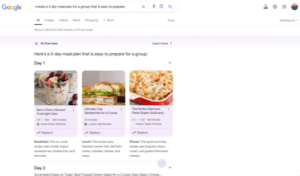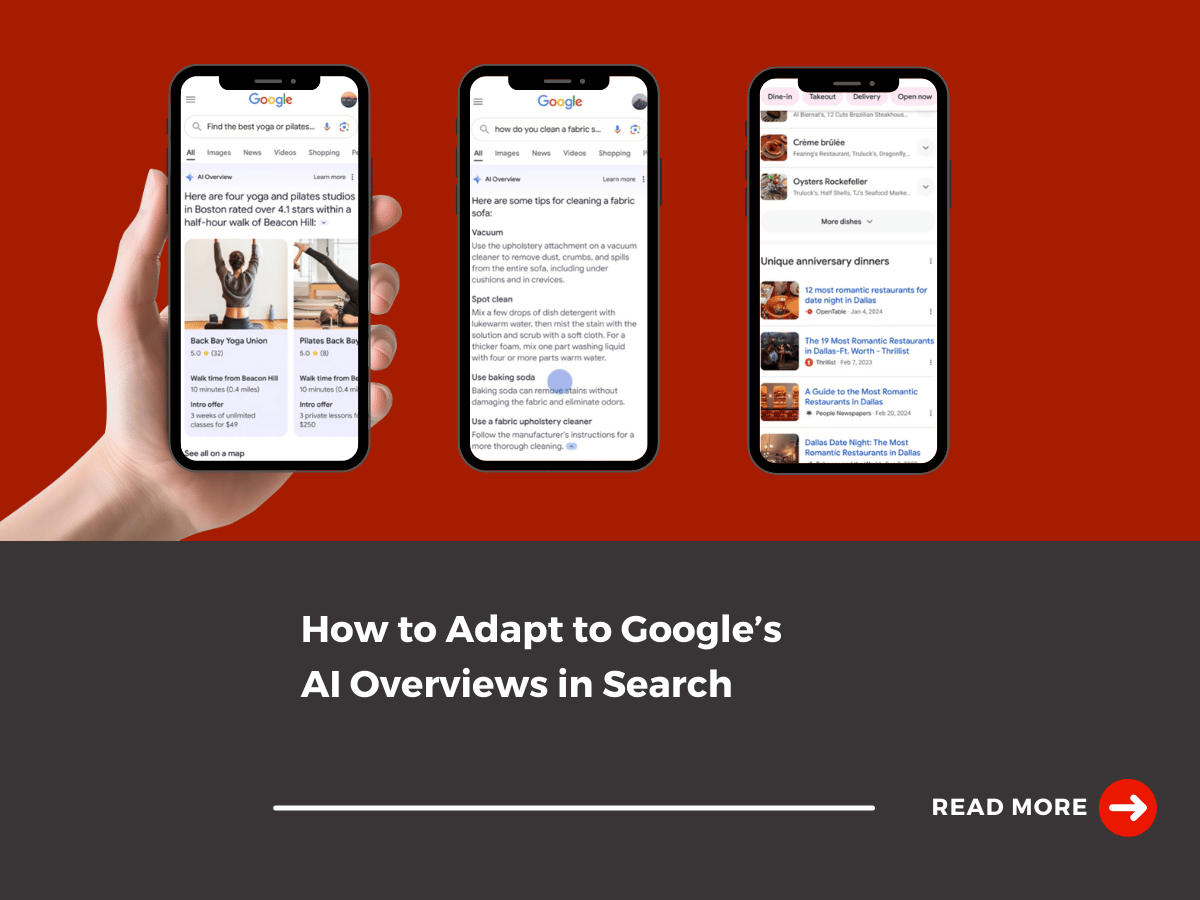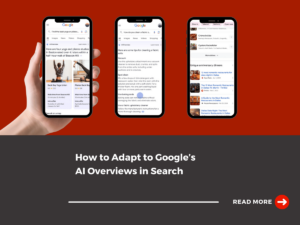If you’ve been using Google recently, you may have noticed a new feature at the top of search results: AI Overviews (AIO). These generative AI summaries simplify the search process by providing a concise, comprehensive summary featuring links and information from various websites.
Curious about how to rank in AI Overviews? Here’s everything you need to know.
What is Google AIO?

Google AI Overviews are generative AI summaries that appear at the top of the search engine results page (SERPs), above organic listings. These summaries provide a quick, easy-to-understand overview of a topic, compiled from relevant content across the web.
This feature eliminates the need to click back and forth between websites, streamlining access to valuable information. AIO changes how content surfaces in SERPs, emphasizing the importance of accuracy and relevance to rank in this prime real estate.
Why You Should Care About AI Overviews
Google’s AI Overviews (AIO) are rapidly transforming the search engine landscape, taking up significant retail space at the top of search engine results pages (SERPs). These generative AI summaries often appear above organic listings, pushing traditional search results further down the page and reducing their visibility.
| Aspect | Traditional SEO | AI Overview-Focused SEO |
|---|---|---|
| SERP Layout | Organic listings dominate | AI Overviews occupy top positions |
| Content Strategy | Broad, general content | Highly specific, passage-focused content |
| User Behavior | High click-through on organic results | Increased zero-click searches |
| Keyword Strategy | Broad targeting with many keywords | Focus on high-impact, specific keyword mapping |
| Multimedia Usage | Optional visual enhancements | Essential for engagement (charts, graphs, etc.) |
The Rise of Zero-Click Searches
With the prominence of AI Overviews, the trend of zero-click searches—where users find answers directly on the search page without visiting a website—has grown significantly. This shift poses challenges for businesses relying on organic traffic, as users may never reach their websites.
The Impact on Organic Rankings
AI Overviews don’t just occupy prime SERP real estate; they fundamentally alter user behavior. Ranking on page one is now more critical than ever because:
- Lower Visibility for Page Two Results: Organic listings beyond page one are less likely to attract clicks due to their reduced prominence.
- Increased Competition for Top Spots: Securing a spot within the AI Overview or on page one ensures that your content remains visible and competitive.
Why You Need to Adapt
To stay relevant in this evolving landscape, businesses must adapt their SEO strategies to prioritize AI Overview optimization and ensure their content appears prominently in organic results. Focusing on keyword relevance, content specificity, and passage-based ranking can help maintain visibility despite these changes. Additionally, incorporating paid media strategies can supplement organic efforts, ensuring a strong presence in highly competitive SERPs.
Strategies to Rank in AI Overviews
AI Overviews are redefining traditional SERP rankings. Since the top position is occupied by the AI summary, diversifying your content strategy is critical.
Focus on Content Specificity
Content specificity is key. Google’s passage-based ranking uses AI to identify the most relevant sections or “passages” within your content. To align with this:
- Write precise, detailed, and topic-specific content.
- Avoid long, generic paragraphs.
- Include succinct, insightful answers tailored to specific queries.
Adding FAQ sections with proper schema markup can further enhance your chances of ranking in AI Overviews by helping search engines understand context and intent.
Utilize Tools to Uncover Content Opportunities
You can use many online tools and resources to revamp your AI overview SEO strategy:
- Google Search Console (GSC): Identify underperforming queries.
- RivalFlow AI: Refresh content to better align with search intent.
- SEMRush/Moz: Uncover keyword gaps and high-impact opportunities.
Incorporate Multimedia Content
To keep up with the trends, you’ll also want to diversify your content to align with the AI-influenced search results. Multimedia content engages audiences and aligns with modern search trends. Incorporate:
- Incorporate photos, graphs, or charts (Canva)
- Develop video content (Lumen5)
- Add creative designs or interactive content (Gemini AI)
- Create a weekly podcasts (Audacity)
Prioritize Keyword Analysis & Mapping
Regularly optimizing and refreshing your content is essential for maintaining SERP visibility. Here’s how to prioritize keywords effectively:
Step #1: Analyze Current Keyword Performance
To improve your content performance, start by reviewing your current keyword performance data and filtering out underperforming and low-value keywords. Follow these steps:
- Use Keyword Research Tools: You must measure and track keyword performance effectively through backed data and metrics.
- Identify Changes & Losses: Look for keywords that have declined in rankings or dropped out of the SERPs altogether.
- Filter Low-Value Keywords: Exclude keywords with a low monthly search volume and keywords in position 50-100. If your content hasn’t ranked well for these keywords before, it likely won’t rank well moving forward.
- Highlight Priority Terms: Focus on the rest of the high-impact keywords that are left and have the highest potential for getting your content to rank.
Step #2: Conduct Individual Keyword Analysis
Perform a detailed analysis of each targeted keyword to identify high-impact opportunities. Consider these factors for each keyword:
- Relevance: Does the keyword intent align with your goals and the searcher’s needs?
- Competition: Are the SERPs dominated by authoritative sites (e.g., .gov, .edu, or trusted brands) that may be challenging to outrank?
- Ranking Issues: Are other pages on your site already ranking better for this keyword? If so, evaluate whether to consolidate or refine content.
This step ensures your efforts are focused on the most impactful keywords.
Step #3: Choose a Keyword-Specific Content Strategy
After identifying high- and low-impact keywords, decide whether to refresh existing content or create new content.
- Refresh Old Content for Underperforming Keywords:
- Address content cannibalization if multiple pages are competing for the same keyword.
- Refine and optimize existing pages to align with search intent and improve accuracy.
- Remove irrelevant keywords to avoid confusing search algorithms.
- Create New Content for Gaps and Underperforming Keywords:
- Develop new, detailed, and topic-specific content to target high-potential keywords that aren’t adequately addressed by your current content.
- Use search intent and SERP analysis to guide content creation.
- Align new content with Google’s passage-based ranking to ensure it provides comprehensive, query-specific answers.
Both approaches will help you maximize your chances of ranking for high-impact terms while addressing keyword gaps effectively to create engaging content.
Wrapping Up: Capitalize on AI Overview SEO
Google AI Overviews are reshaping traditional SEO strategies, presenting new opportunities to enhance visibility and outrank competitors. By leveraging keyword research, content specificity, and multimedia strategies, you can stay ahead of the curve.
Need help adapting your SEO strategy for AI-driven search results? Contact our digital marketing experts today!




